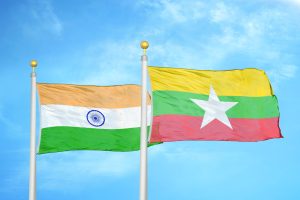Rajeswari Pillai Rajagopalan

On November 20-21, Indian Foreign Secretary Vinay Kwatra made a two-day visit to Myanmar. The Indian Ministry of External Affairs (MEA) in a press release stated that he met with members of the military junta that is currently ruling the country and discussed security and stability in the border areas, human trafficking issues (several Indian nationals have been victims), and infrastructure development. Kwatra was received by Lt. Gen. Yar Pyae, a member of the State Administration Council and minister at the Union Government Office. According to Myanmar National portal, the two sides held discussions on “Myanmar-India friendly relations, exchanged views on the promotion of bilateral cooperation and the implementation of Myanmar’s peace process.”
Strangely, the MEA statement made no mention of any Indian interest in seeing Myanmar return to the path of democracy or the release of political prisoners and other tricky issues. On the contrary, the foreign secretary spoke about continued Indian support for “people-centric socio-economic developmental projects” and early completion of connectivity projects including the Kaladan Multimodal Transit Transport Project and the Trilateral Highway between India, Myanmar, and Thailand. It appears that infrastructure and developmental projects were a big emphasis during the visit because Kwatra also assured the Myanmar junta about projects under Rakhine State Development Program and Border Area Development Program. Despite the MEA press release not mentioning it, the MEA spokesperson Arindam Bagchi tweeted that the foreign secretary had discussions on several important issues including “India’s support to democratic transition in Myanmar.”
Commentators argue that these “omissions are revealing.” Contrast this with the December 2021 statement that the MEA issued following then-Foreign Secretary Harsh Vardhan Shringla’s visit where he “emphasized India’s interest in seeing Myanmar’s return to democracy at the earliest; release of detainees and prisoners; resolution of issues through dialogue; and complete cessation of all violence.” He had also reiterated that “India’s strong and consistent support to the ASEAN initiative and expressed hope that progress would be made in a pragmatic and constructive manner, based on the five point consensus.” This time around, the visiting official reportedly did not have any meetings with the opposition National Unity Government, including its leader, Aung San Suu Kyi, who were overthrown by the military junta in a military coup in February 2021. This raises questions about India’s evolving position, indicating possibly a softer approach to the ruling military junta.
Human trafficking has emerged as a major issue in Myanmar, with several criminal syndicates running a racket luring Indian citizens with fake job prospects. The MEA spokesperson, according to media reports, cautioned Indian nationals of being wary of trafficking while stating that “We are aware of IT companies recruiting Indian workers in the pretext of jobs in Thailand, who were then taken to Myanmar. Thanks to our efforts, we have facilitated the rescue of some of those people. We urge Indian nationals to exercise caution before taking up job offers there.” There have been reportedly close to 200 Indian nationals who have been duped into this job racket.
There has been much speculation on the rationale for the foreign secretary’s visit to Myanmar. Strategic factors appear to be driving India’s greater engagement with the military junta, especially fear of China and Pakistan making inroads into the country. Since the military coup, China has improved on its good relations with the military junta, providing much-needed support for the Myanmar leadership in the face of international opprobrium.
China reportedly has been a key source of foreign investment in Myanmar. China’s multiple projects include several high-speed railway lines and dams as well as a $2.5 billion investment in a gas-fired power plant to be developed west of Yangon, with three Chinese companies owning 81 percent of the project and the remainder being held by Myanmar’s Supreme Group of Companies. The China-Myanmar Economic Corridor, which consists of oil and gas pipelines and infrastructure development projects run into billions of dollars. Of particular interest to China is the deep sea port that China plans to develop at Kyaukphyu, on Myanmar’s west coast, budgeted at around $7 billion. This will possibly give China better access to the Indian Ocean, which China has been eyeing for a while.
Additionally, the budding relationship between Myanmar and Pakistan is also of some concern to India. According to media reports, Myanmar took the delivery of six JF-17 light-weight multi-role fighter jets from Pakistan in 2018 after signing a contract two years earlier in 2016. Reportedly, Pakistani military officers had traveled to Yangon in September 2021. Myanmar was to get another batch of 10 aircraft although the date of delivery is unknown. This has not been a very successful venture for either side. According to the latest reports from The Irrawaddy, “most of the newly acquired Chinese and Pakistan-made JF-17 fighter jets that the Myanmar regime has taken delivery of have been grounded due to technical malfunctions, according to analysts and former Myanmar Air Force pilots who monitor the junta’s air capabilities.”
Pragmatism on account of the growing presence and inroads of China in Myanmar has possibly pushed India to give up on its moralizing about democracy and increase its outreach to Naypyidaw. While the pro-democracy elements within Myanmar as well as India’s strategic partners in ASEAN may not be particularly pleased with this outreach, especially India dropping ASEAN’s Five-Point Consensus on Myanmar, it appears that New Delhi sees itself as having not too many choices.
No comments:
Post a Comment